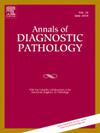Clinical and pathological characteristics and prognostic factors of SMARCA4-deficient non-small cell lung cancer
IF 1.4
4区 医学
Q3 PATHOLOGY
引用次数: 0
Abstract
The objective of the study is to investigate the clinicopathological features and prognostic factors of SMARCA4-deficient non-small cell lung cancer (SMARCA4-deficient NSCLC). A total of 43 patients with SMARCA4-deficient NSCLC who were diagnosed at Baotou Steel Hospital between January 2021 and October 2024 were included. Kaplan-Meier survival curves were plotted, and the log-rank test was used for group comparisons. Cox regression analysis was performed to identify factors influencing the 2-year overall survival in SMARCA4-deficient NSCLC patients. SMARCA4-deficient NSCLC patients exhibited distinct characteristics: older age (P < 0.05), male predominance (P < 0.05), smoking history (P < 0.05), larger tumors (P < 0.05), higher Ki-67 index (P < 0.05), lower EGFR mutation rates (P < 0.05), fewer squamous carcinomas (P < 0.05), and more poorly differentiated tumors (P < 0.05). Immunohistochemistry revealed BRG1 loss in 93.0 % (40/43), with TTF-1 (76.7 %) and P40 (81.4 %) negativity. The 2-year survival rate was significantly worse in SMARCA4-deficient NSCLC vs. SMARCA4-intact NSCLC (log-rank P < 0.001). Multivariate Cox analysis identified age ≥ 65 years (HR = 2.8, P = 0.003), smoking (HR = 2.4, P = 0.012), tumor size >5 cm (HR = 3.1, P < 0.001), and distant metastasis (HR = 4.5, P < 0.001) as independent predictors of poor survival in SMARCA4-deficient NSCLC. Patients with advanced-stage disease (III/IV) had significantly shorter survival (P < 0.05). SMARCA4 deficiency defines an aggressive NSCLC subtype with unique clinicopathological traits, including rapid progression, and poor survival.
缺乏smarca4的非小细胞肺癌临床病理特征及预后因素分析
本研究的目的是探讨smarca4缺陷非小细胞肺癌(smarca4缺陷NSCLC)的临床病理特征及预后因素。共纳入了2021年1月至2024年10月期间在包头钢铁医院诊断的43例smarca4缺陷NSCLC患者。绘制Kaplan-Meier生存曲线,采用log-rank检验进行组间比较。采用Cox回归分析确定影响smarca4缺陷NSCLC患者2年总生存率的因素。缺乏smarca4的NSCLC患者表现出明显的特征:年龄较大(P <;0.05),男性优势(P <;0.05)、吸烟史(P <;0.05),较大的肿瘤(P <;0.05), Ki-67指数较高(P <;0.05), EGFR突变率降低(P <;0.05),鳞状癌较少(P <;0.05),低分化肿瘤较多(P <;0.05)。免疫组化显示BRG1缺失93.0% (40/43),TTF-1(76.7%)和P40(81.4%)阴性。smarca4缺失NSCLC的2年生存率明显低于smarca4完整NSCLC (log-rank P <;0.001)。多因素Cox分析确定年龄≥65岁(HR = 2.8, P = 0.003)、吸烟(HR = 2.4, P = 0.012)、肿瘤大小>;5 cm (HR = 3.1, P <;0.001),远处转移(HR = 4.5, P <;0.001)作为缺乏smarca4的非小细胞肺癌生存率差的独立预测因子。晚期疾病(III/IV)患者的生存期明显缩短(P <;0.05)。SMARCA4缺陷定义了一种侵袭性NSCLC亚型,具有独特的临床病理特征,包括快速进展和较差的生存率。
本文章由计算机程序翻译,如有差异,请以英文原文为准。
求助全文
约1分钟内获得全文
求助全文
来源期刊
CiteScore
3.90
自引率
5.00%
发文量
149
审稿时长
26 days
期刊介绍:
A peer-reviewed journal devoted to the publication of articles dealing with traditional morphologic studies using standard diagnostic techniques and stressing clinicopathological correlations and scientific observation of relevance to the daily practice of pathology. Special features include pathologic-radiologic correlations and pathologic-cytologic correlations.

 求助内容:
求助内容: 应助结果提醒方式:
应助结果提醒方式:


